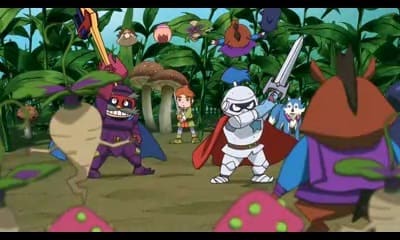Return to PopoloCrois: A STORY OF SEASONS Fairytale has finally been dated! Set your calendars, your watches, and anything else you’ve got for March 1st, because that’s when the best game your friends have never heard of (but will surely hear of through you) drops into retailers across North America, and on the North American eShop as well!
(And overseas Popolo-heads, don’t fret: Marvelous Europe will be announcing their own release date for the game very soon!)
We’ve got ourselves a cool new website at https://www.returntopopolocrois.com with all the info you could ever ask for (I wrote it, so trust me, it’s pretty thorough!), and a cool new trailer to boot:
And as promised in an earlier blog, I’m going to go over some of the bells and whistles featured in Return to PopoloCrois that we haven’t really talked about yet (most of which are mentioned on the website too, but I’m going to go into far more meticulous detail here), because we went to great lengths to make this as accessible and fun an experience for you guys as possible. So, without further ado, let’s start with the one feature we’ve been asked about the most:

“Trual” Voice
I keep trying to get the term “trual” to catch on, but somehow, I think I’m fighting a losing battle on that one! Either way, whether you’re a dubber or a subber, you’ll be pleased to hear that Return to PopoloCrois is going to offer both a full English dub, as well as the original two Japanese audio tracks. And yes, there are two… sort of. Most of the game only features a single set of Japanese voices, but the main characters Pietro and Narcia each have two different actors in the original Japanese: one “classic” actor (who plays the role in a very ‘90s style), and one “modern” actor (who plays the role with more of a familiar “moe” bent). The classic actors include Ai Orikasa (Ryoko in Tenchi Muyo, Fee Carmichael in Planetes, Quatre in Gundam Wing) as Pietro and Yuri Shiratori (Mokona in Rayearth, Yukina in YuYu Hakusho, Nanami in Utena) as Narcia, and are the ones I’m most familiar with from other PopoloCrois works, while the modern actors include Maaya Sakamoto (Hitomi in Escaflowne, Tomoe in Tiger & Bunny, Rikako in Psycho Pass) as Pietro and Ayako Kawasumi (Saber in Fate, Kaori Misaka in Kanon, Gedomaru in Gintama) as Narcia.
As for our English actors… well, they’re a secret. But you can hear a little bit of them in the newly released trailer – and you can hear samples from both the English and the dual Japanese voice sets in our website’s character section, too!

King Difficulty
Return to PopoloCrois is not exactly a difficult game, with only the last few major bosses at risk of being a moderate struggle for RPGers. Fortunately, it seems many others agreed with me on this point, so an additional hard mode was introduced to the game. The original release in Japan only included two difficulty levels, which we translated as “Seedling” and “Prince,” but a later Japanese patch added a third difficulty level which we’ll be including from the start in our English release. In keeping with “Prince” as the previous hardest difficulty, we decided to label this one “King.”
What’s cool about the difficulty level in Return to PopoloCrois is that you can change it at will, anytime you’d like (well, anytime the config menu is accessible to you, anyway). This game isn’t meant to be a grindfest or a test of wills, after all, but rather to entertain and charm, so even if you’ve played the whole game on King mode and are finding the final boss a little too difficult for you thanks to all the battles you skipped in the final dungeon (which surely didn’t happen to me, I swear!), you can always switch to Seedling mode at the 11th hour with no penalty whatsoever… and no one ever has to know!

Encounter Rate Toggle
Let’s get this out of the way right now: Return to PopoloCrois has random battles. Yes, I know, that’s an old-fashioned concept… but this is an old-fashioned game! I wasn’t kidding when I said in a previous blog that it feels like a long-lost remnant of the 32-bit era. And the battle system is honestly pretty fun, with lots of story scenes and minigames to break it up and keep things fresh (including the STORY OF SEASONS-inspired farming minigame, which is omnipresent but completely optional), so it’s really more nostalgic than anything else.
Naturally, though, the encounter rate became a source of grumbles for some Japanese fans following the game’s original release, so an encounter rate toggle has been added. Like the difficulty level, you can change this at will anytime you have access to the config menu, and you’re given three options: Low, Med, and High. “High” is actually what the game defaulted to in its original Japanese release, with “Med” representing 50% of that, and “Low” representing 25%. If you’re a seasoned RPG veteran, I highly recommend playing on King difficulty with the encounter rate set to Low – not only will this ensure random battles occur at a more comfortable rate, but it will also ensure those battles are more challenging (since the lower number of them will mean less leveling-up along the way).
One other related note is the inclusion of a consumable item in the game called “Monster Bane.” You start seeing this for sale at various in-game shops around the adventure’s halfway point, though it’s a bit pricey at first. Eventually, though, you’ll be able to afford a full stock of these, and they can help you mitigate random encounters even further… by preventing any from happening at all for the duration of their use! And while Monster Bane only lasted around 30 seconds in the original Japanese release, the patched version of the game – and by extension, our English version – has the effect of Monster Bane lasting significantly longer, meaning you’ll only need 2 or 3 of them to get through an entire dungeon without fighting a single battle.

Spell Animation Skipping
This is a quality-of-life improvement that we suggested to the developers, and is unique to our English release of the game. During battle, any and all spell animations – whether they be spells cast by one of your party members or by an enemy – can be skipped simply by pressing the A Button. This may not seem like a particularly big deal, but there are some spells you’ll be casting an awful lot, and a few of them take a reeeeeeally long time to play out, so I think most of you will find this to be a very nice addition as you progress through the game’s main campaign.

Quicksaving
Although you generally save your game at inns (how old-school is that?!), you do have the option to open the menu during play and select “Quicksave” to instantly save your progress as needed, making this a great game to play on the go. This was present in the Japanese version of the game as well, but as a “temp save” feature – meaning, when you loaded your quicksave, the game would erase it from the SD card. Temp saves have always kind of rubbed me the wrong way, so we successfully lobbied to have this changed to a standard quicksave feature for the game’s English release – meaning, the save data will never be erased from your SD card, load or no load! This seems more in keeping with the fun, relaxing spirit of this title, and also effectively gives you a third save slot in case you’ve got multiple siblings who want to play Return to PopoloCrois as well (and if you have multiple siblings, I think it goes without saying that they WILL want to play this game!).

“The Galari”
A PopoloCrois tradition, this mode is selectable from the title screen and allows you to view any movie file you’ve seen in-game thus far (including the ending, once you’ve beaten it). What makes this especially cool is that you’re given the option to view these movies in English or Japanese – so you don’t have to replay a long story scene just to view its insert movie in another language; instead, you can check it out in the Galari at your convenience. It even lets you select from either Japanese voice track, in the case of movie files featuring Pietro and/or Narcia. And of course, when viewing a movie file with one of the Japanese voice tracks selected, the spoken dialogue is subtitled on the bottom screen for your convenience.

Cel-Shading Style Selection
Here’s a feature that doesn’t get brought up very often, but is actually pretty neat! If you’ve been following this title for a while, and looking at screenshots as they’ve been released both here and in Japan, you might have noticed that the characters have thick, black outlines around them in some, but not in others. This is because both are entirely viable play options: referred to in the config menu as “Trace Outline,” you can toggle this feature on or off at any point during gameplay to have your characters outlined in black or given a smoother, outline-free look. I personally prefer playing with the Trace Outline set to off, which is why most of the screenshots we’ve released don’t have it – but even within the office, there are some who prefer leaving it on. Which way do you think looks better?


…I could go on to list more, but this is already the longest blog entry I’ve ever written – which is pretty impressive, considering I’m known for writing very long things!
So I’d like to conclude by mentioning the one extra little cool detail we managed to sneak into this release for you guys… or rather, into its official website. See, we couldn’t offer a limited-edition box set this time around, but we wanted to give you SOMETHING cool to make this release extra-special, so we looked into licensing the original PopoloCrois Story manga for translation and publishing on the game’s website. Amazingly, we were able to secure the rights to the manga’s first full story (which is 113 pages long), and you can read its first arc (which is 18 pages) right now by heading on over to https://www.returntopopolocrois.com and clicking the “Manga” link. We’ll be adding more story arcs every Tuesday leading up to the game’s North American release on March 1st, giving you ample opportunity to familiarize yourself with the characters and the world as they were originally designed in 1978 (yeah, they’re really that old!) before seeing what’s become of them in 2016. It’s an unprecedented historic look into this amazing franchise, and is the very first time the PopoloCrois manga has ever been made available to read in English.

I hope you enjoy it, and I can’t wait for this game to release so I can read everyone’s impressions! I had an absolute blast working on it, and will forever be grateful to have been given the opportunity.
Until next time, my Popolo peoples!
-Tom

